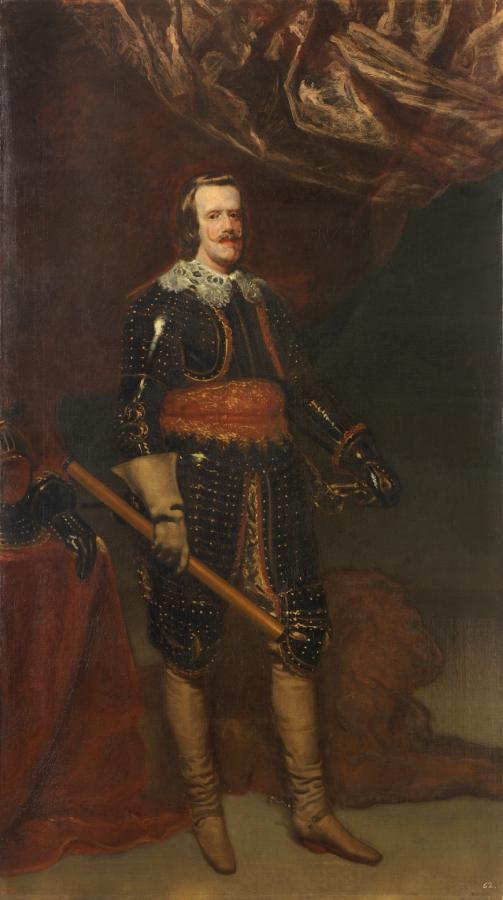Velázquez, Diego (1599-1660)
Felipe IV armado, con un león a los pies (Philip IV in Armour, with a Lion at his Feet)
c.1653
Oil on canvas, 234 x 131.5 cm
Museo del Prado, Madrid
In its present state the painting reveals two different phases of creation. The apparent age of the sitter and the notable similarities with his appearance in Velázquez‘s portrait of the elderly Philip IV in the Museo del Prado (P01185) have meant that this painting is generally dated to the 1650s. However, technical studies have revealed important changes, primarily affecting the head and right side of the work. The head was originally turned more towards the sitter’s left while the hair was shorter and Philip was depicted as more youthful in appearance. The right-hand side opened out towards a balustrade that gave onto a broad landscape. There are also changes to the curtain, which has been enlarged. The scope and nature of these changes indicate that it was reworked from an earlier model, for which some suggestions regarding a date can be made. The original length of the hair and the King’s features indicate the late 1630s, while the type of armour is similar to that worn by Philip and the Count Duke of Olivares in their equestrian portraits or to that worn by Spinola in The Surrender of Breda (P01172), all of them works from the mid- or late 1630s. The changes made to Philip IV in Armour, with a Lion at his Feet, created in the late 1630s, must date from the mid-1660s. This is demonstrated by a lost portrait of Charles II as a boy, which is known as it appears in The Paintings Gallery of the Archduke Leopold William (Munich, Alte Pinakothek) by David Teniers (ca. 1610-1690). The young prince has the same pose as his father, wears similar armour with the helmet again on a table, a lion in profile at his feet and a curtain behind him. In the right-hand part of the image there is a balustrade similar to the one that originally appeared in the portrait of the King, proving that the latter was modified after 1665, which is the date of the portrait of his son, to judge from his apparent age. The overpainting of the balustrade was probably due to the desire to unify this work with the portrait of Mariana de Austria (P01191), who is located in an interior. This is one of the portraits of Philip IV that places most emphasis on his military responsibilities. The King is shown standing, wearing armour, with a sash and staff of office that refer to his rank, his left hand on the pommel of his sword. Philip wears riding boots with spurs, a combination that would have held meaning for contemporary viewers who were accustomed to associate military command with equestrian culture. The helm and gauntlet rest on the table while on the floor is a lion, traditionally associated with contexts of power and evoking the idea of strength. With regard to the attribution of this canvas, it can be considered a typical studio project in the sense of being a work that is comprehensible only in relation to its closeness to Velázquez, the principal court portraitist, who devised its composition, but one that was actually painted by one of his assistants who imitated the most superficial aspects of his pictorial handling (Text from Portús, J.: Velázquez. Las Meninas and the Late Royal Portraits, Museo Nacional del Prado, 2013, pp. 110-113).
See also:
• Felipe IV, King of Spain (1605-1665)
